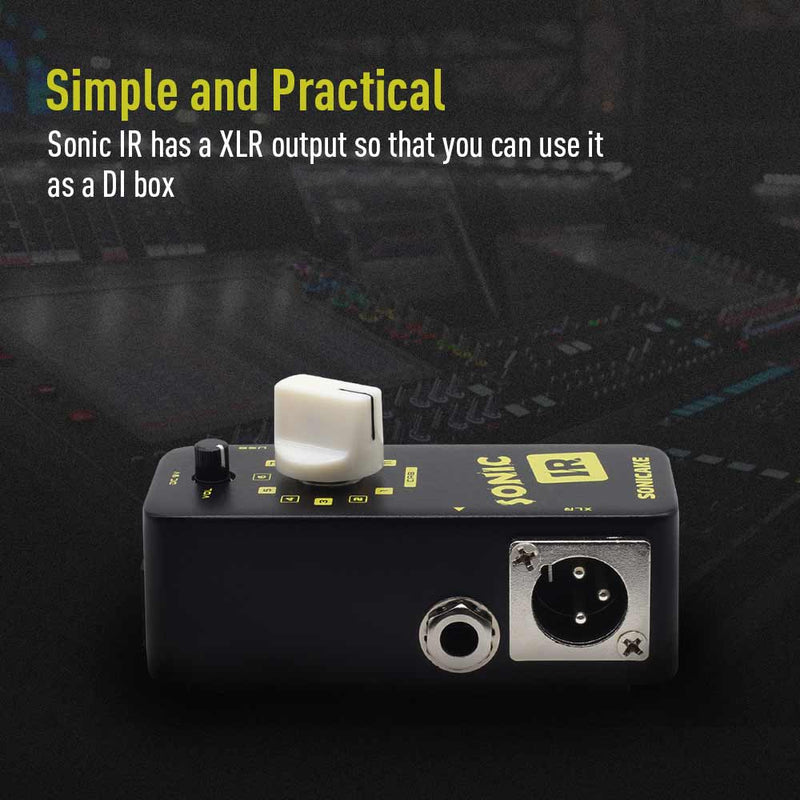Achieving the perfect tone can often feel like a never-ending quest. Enter the Sonicake Sonic IR Loader pedal, a device designed to revolutionize your sound by offering a range of Impulse Responses (IRs) that can simulate various cabinets, microphones, and environments. This compact yet powerful tool is gaining traction among bassists for its versatility and ease of use.

SO, What Is SONIC IR?
The SONIC IR is an impulse response (IR) loader. It simulates various speaker cabinets, allowing you to achieve different tones without hauling around heavy cabs. Here are some key features:
- Classic Cabinet Simulations: The pedal comes with 11 onboard guitar and bass cabinet simulations.
- Custom IR Loading: While the built-in presets are great, the real magic is it allows you to load your own IR files. Simply connect the pedal to your computer via USB, drag and drop your IR files, and you’re ready to go.
- Easy Operation: No complex menus or software—just drag and drop.
- Balanced XLR Output: Connect directly to a mixer, audio interface, or PA system using the XLR output. No need for additional DI boxes.
How to Use It
- Load Your IRs: Connect the SONIC IR to your computer and it will be detected as a USB storage device. drop your IR files onto the pedal (remember to follow the naming conventions like 01 – AmpegSVT, 02 – Bassman…etc.), and restart it.
- Select Your Cab: Cycle through the 11 presets or your custom-loaded IRs to find the perfect cabinet sound for your rig.
BUT WAIT! There’s a big problem..
In my excitement to explore the potential of the SONIC IR pedal, I hit a roadblock. Loading third-party impulse responses (IRs) turned out to be more challenging than expected. Let me share my findings:
- The IR Format Challenge:
- I tried some free IRs I stumbled upon online, including the popular Shift Line bass IR pack. However, the SONIC IR has specific requirements: it accepts 24-bit, 44.1 kHz .wav files. Unfortunately, most of the IRs I found didn’t meet these criteria.
- The stock IRs bundled with the SONIC IR are tiny—around 4 KB in file size. In contrast, the other IRs I discovered were much larger.
- Sonicake’s Solution:
- My frustration led me to find out that Sonicake provides its own IR converter, designed specifically for the SONIC IR pedal. (I didn’t know this at first as I only discovered the SONIC IR from a youtube video ) Although it is slow at times and maybe janky but easy to use.
- Instead of struggling with resampling IRs in my digital audio workstation (DAW), I decided to give the Sonicake converter a shot and this gave me fantastic results
- The converted IRs worked seamlessly with the SONIC IR, preserving their quality and fidelity.
Inspired by this, I spent some quality time compiling and converting various BASS IR packs. These packs are now ready to use with the SONIC IR.
If you’re a fellow user facing the same dilemma, fear not! Feel free to explore the IRs I’ve prepared. And hey, if you have your own custom IRs, don’t hesitate to share them with us.
- Ampeg SVT 8×10 from Tonehunt.org
- Darkglass Elite 4×12 from Tonehunt.org
- Darkglass Elite 8×10 from Tonehunt.org
- Drums and Tones Free IR Bass pack
- Eden Nemesis 4×10 by DLS Digital
- Pandacabs Darkglass Tones
- Shiftline Bass IR Pack
- Gallien Krueger GK 250ML
- Ashdown MAG 410 T Deep
- Trace Elliot 1248H
Here’s what I love about the Sonic IR
- Versatility: One of the standout features of the Sonic IR Loader is its versatility. Bassists can simulate a variety of cabinet and mic combinations, from vintage Ampeg tones to modern, punchy sounds. This flexibility is particularly useful for players who perform across different genres or need a specific tone for recording.
- Compact and Portable: The pedal’s compact size makes it an ideal choice for gigging musicians. It fits easily on any pedalboard and doesn’t add much weight, which is a significant advantage for those who are constantly on the move.
- Ease of Use: Setting up the Sonic IR Loader is straightforward. With a user-friendly interface, bassists can quickly load and switch between different IRs, making it easy to find the right tone for any situation. The ability to store multiple presets means you can have your favorite sounds ready at the tap of a footswitch.
- Enhanced Sound Quality: The Sonic IR Loader can significantly enhance the sound quality of your bass rig. By using high-quality IRs, you can achieve a professional, studio-grade tone whether you’re playing live or recording. The pedal allows for detailed adjustments, ensuring that your bass cuts through the mix with clarity and presence.
Practical Applications
Live Performances: During live performances, the Sonic IR Loader can be a game-changer. By simulating different cabinets and microphones, you can adapt your sound to fit the venue’s acoustics. This means more consistent and better-controlled bass tones, reducing the reliance on venue-specific backline equipment.
Recording Sessions: In the studio, the Sonic IR Loader offers a plethora of tonal options without the need for multiple physical cabinets and microphones. This not only saves space but also provides the ability to quickly switch between different sounds to find the perfect match for a track.
Practice and Jamming: For practice and jamming, the Sonic IR Loader can provide a more enjoyable and inspiring experience. By simulating high-quality cabinet sounds, you can practice with tones that closely mimic your live or studio setup, making rehearsals more productive.
The Bottom Line
By offering high-quality IR simulations in a compact and user-friendly format, it allows bassists to achieve professional-level tones without the need for extensive physical gear. Whether you’re a gigging musician, a recording artist, or someone who simply enjoys jamming, this pedal is a worthy addition to your arsenal.

